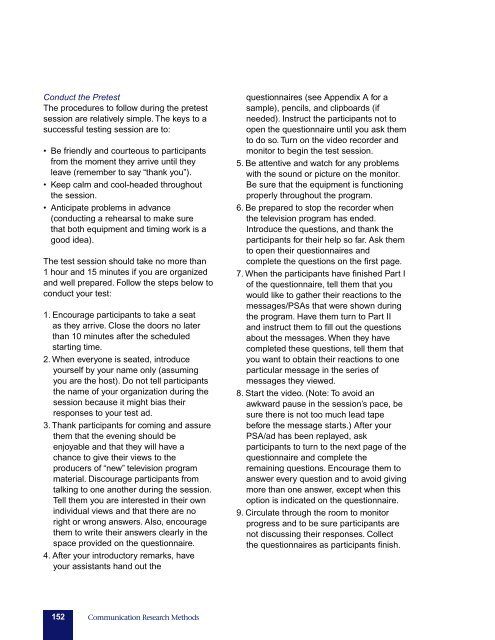pink-book
pink-book
pink-book
You also want an ePaper? Increase the reach of your titles
YUMPU automatically turns print PDFs into web optimized ePapers that Google loves.
Conduct the Pretest<br />
The procedures to follow during the pretest<br />
session are relatively simple. The keys to a<br />
successful testing session are to:<br />
• Be friendly and courteous to participants<br />
from the moment they arrive until they<br />
leave (remember to say “thank you”).<br />
• Keep calm and cool-headed throughout<br />
the session.<br />
• Anticipate problems in advance<br />
(conducting a rehearsal to make sure<br />
that both equipment and timing work is a<br />
good idea).<br />
The test session should take no more than<br />
1 hour and 15 minutes if you are organized<br />
and well prepared. Follow the steps below to<br />
conduct your test:<br />
1. Encourage participants to take a seat<br />
as they arrive. Close the doors no later<br />
than 10 minutes after the scheduled<br />
starting time.<br />
2. When everyone is seated, introduce<br />
yourself by your name only (assuming<br />
you are the host). Do not tell participants<br />
the name of your organization during the<br />
session because it might bias their<br />
responses to your test ad.<br />
3. Thank participants for coming and assure<br />
them that the evening should be<br />
enjoyable and that they will have a<br />
chance to give their views to the<br />
producers of “new” television program<br />
material. Discourage participants from<br />
talking to one another during the session.<br />
Tell them you are interested in their own<br />
individual views and that there are no<br />
right or wrong answers. Also, encourage<br />
them to write their answers clearly in the<br />
space provided on the questionnaire.<br />
4. After your introductory remarks, have<br />
your assistants hand out the<br />
questionnaires (see Appendix A for a<br />
sample), pencils, and clipboards (if<br />
needed). Instruct the participants not to<br />
open the questionnaire until you ask them<br />
to do so. Turn on the video recorder and<br />
monitor to begin the test session.<br />
5. Be attentive and watch for any problems<br />
with the sound or picture on the monitor.<br />
Be sure that the equipment is functioning<br />
properly throughout the program.<br />
6. Be prepared to stop the recorder when<br />
the television program has ended.<br />
Introduce the questions, and thank the<br />
participants for their help so far. Ask them<br />
to open their questionnaires and<br />
complete the questions on the first page.<br />
7. When the participants have finished Part I<br />
of the questionnaire, tell them that you<br />
would like to gather their reactions to the<br />
messages/PSAs that were shown during<br />
the program. Have them turn to Part II<br />
and instruct them to fill out the questions<br />
about the messages. When they have<br />
completed these questions, tell them that<br />
you want to obtain their reactions to one<br />
particular message in the series of<br />
messages they viewed.<br />
8. Start the video. (Note: To avoid an<br />
awkward pause in the session’s pace, be<br />
sure there is not too much lead tape<br />
before the message starts.) After your<br />
PSA/ad has been replayed, ask<br />
participants to turn to the next page of the<br />
questionnaire and complete the<br />
remaining questions. Encourage them to<br />
answer every question and to avoid giving<br />
more than one answer, except when this<br />
option is indicated on the questionnaire.<br />
9. Circulate through the room to monitor<br />
progress and to be sure participants are<br />
not discussing their responses. Collect<br />
the questionnaires as participants finish.<br />
152 Communication Research Methods


